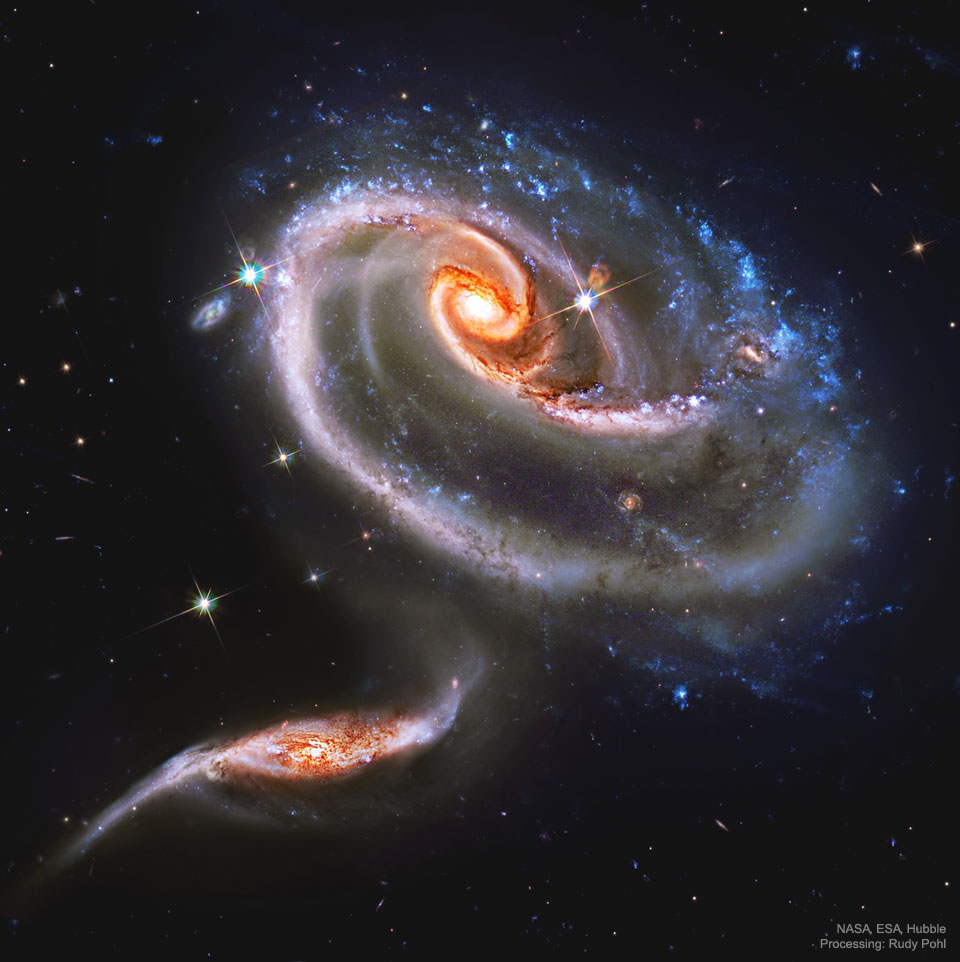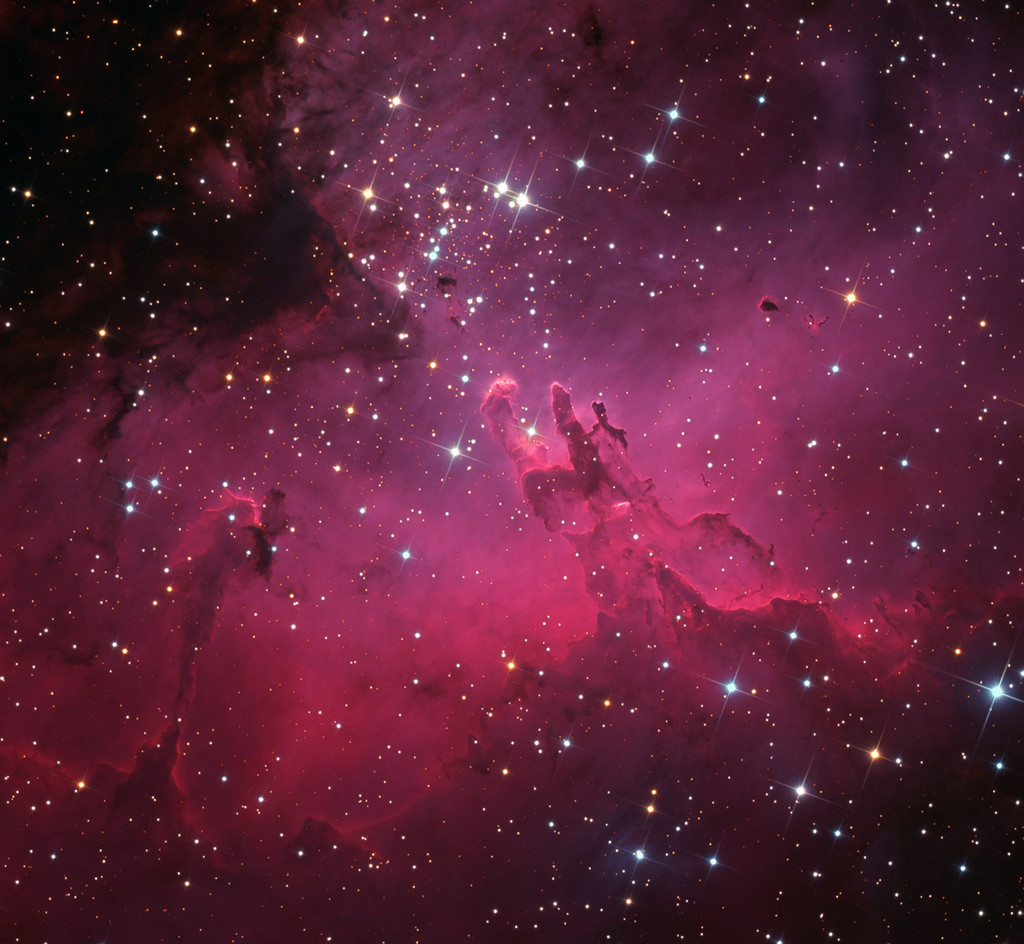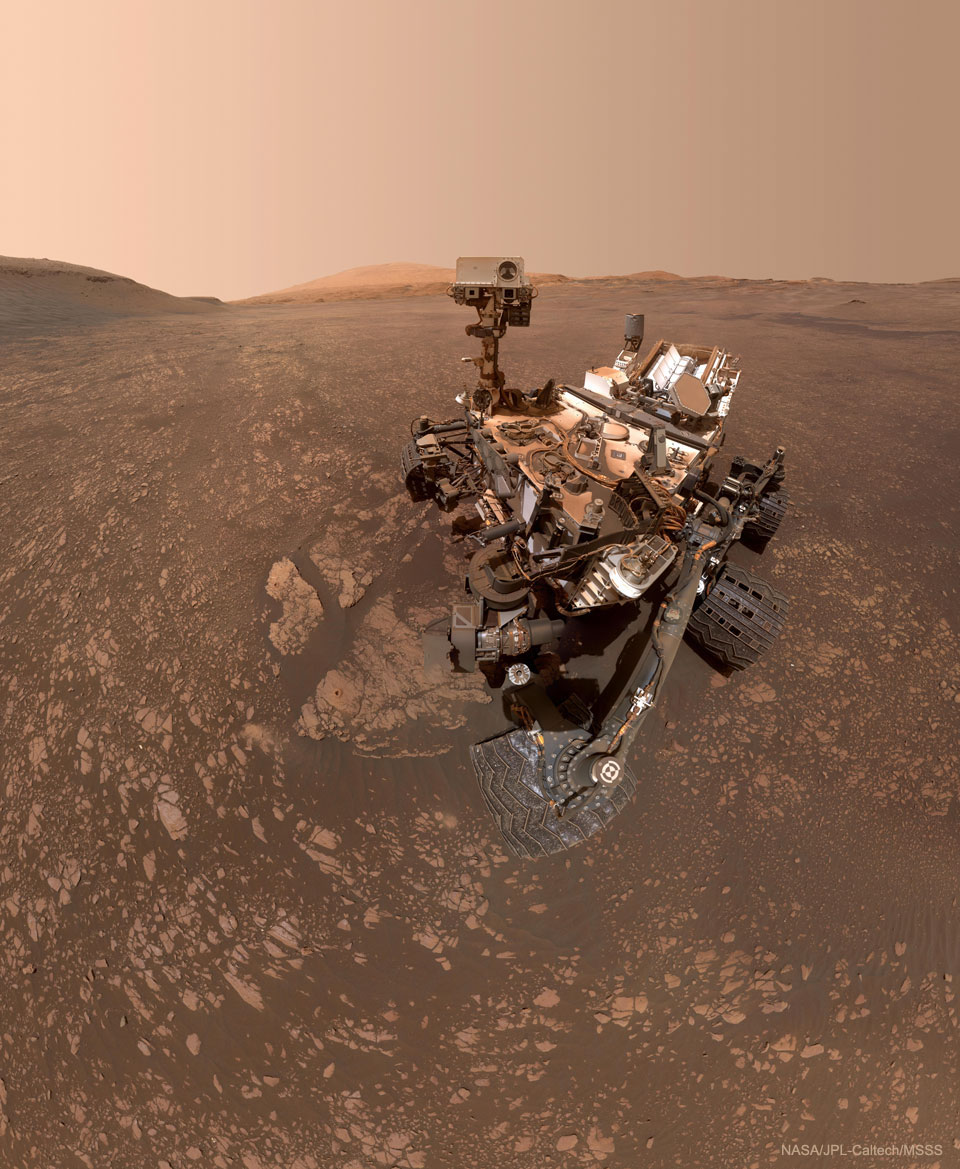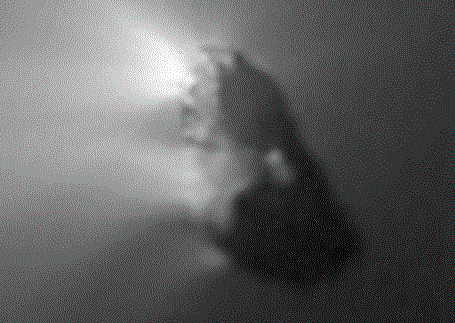Nombre total de pages vues
20/11/2019
Science & Technology - Astronomy picture of the day : Arp 273: Battling Galaxies from Hubble

Image Credit: NASA, ESA, Hubble; Processing & Copyright: Rudy Pohl
Explanation: What's happening to these spiral galaxies? Although details remain uncertain, there sure seems to be a titanic battle going on. The upper galaxy is labelled UGC 1810 by itself, but together with its collisional partners is known as Arp 273. The overall shape of the UGC 1810 -- in particular its blue outer ring -- is likely a result of wild and violent gravitational interactions. The blue color of the outer ring at the top is caused by massive stars that are blue hot and have formed only in the past few million years. The inner part of the upper galaxy -- itself an older spiral galaxy -- appears redder and threaded with cool filamentary dust. A few bright stars appear well in the foreground, unrelated to colliding galaxies, while several far-distant galaxies are visible in the background. Arp 273 lies about 300 million light years away toward the constellation of Andromeda. Quite likely, UGC 1810 will devour its galactic sidekicks over the next billion years and settle into a classic spiral form.
19/11/2019
Science & Technology - Astronomy picture of the day : Milky Way over Uruguayan Lighthouse

Image Credit & Copyright: Mauricio Salazar
Explanation: Can a lighthouse illuminate a galaxy? No, but in the featured image, gaps in light emanating from the Jose Ignacio Lighthouse in Uruguay appear to match up nicely, although only momentarily and coincidently, with dark dust lanes of our Milky Way Galaxy. The bright dot on the right is the planet Jupiter. The central band of the Milky Way Galaxy is actually the central spiral disk seen from within the disk. The Milky Way band is not easily visiblethrough city lights but can be quite spectacular to see in dark skies. The featured picture is actually the addition of ten consecutive images taken by the same camera from the same location. The images were well planned to exclude direct light from the famous lighthouse.
18/11/2019
Ciência e Tecnologia - Saude/Medecina : "Canabis, bom para a saude ?"
Investigadores da Universidade de Western Ontário, no Canadá, realizaram um estudo com vista a perceber os diferentes efeitos psicológicos que a canábis provoca nos consumidores. Publicado este mês na revista Scientific Reports, o estudo representa um grande avanço na compreensão dos efeitos da droga no cérebro humano.
A pergunta de partida para a investigação era há muito uma grande dúvida dos cientistas e da população em geral: qual o motivo de algumas pessoas terem emoções positivas como reação ao consumo de canábis e outras demonstrarem emoções negativas.
Segundo Steven Laviolette, um dos autores do estudo, a premissa levou os investigadores para um campo ainda pouco explorado. “Sabemos muito sobre os efeitos a longo e a curto prazo, mas há muito pouco conhecimento sobre as áreas específicas do cérebro que são responsáveis pelo controlo desses efeitos”.
E a resposta pode ter a ver com as diferentes partes do cérebro, em particular, qual das partes é mais sensível ao tetraidrocanabinol (THC), substância psicoativa libertada pela canábis. Em algumas pessoas, a parte do cérebro mais sensível é a frontal e, nesse caso, provoca sentimentos de conforto, tranquilidade e felicidade. Se a parte mais sensível à substância for a região posterior do cérebro, a droga fará a pessoa sentir medo e alguma paranoia infundada.
Esta investigação foi realizada em ratos de laboratório, mas os cientistas acreditam estar muito mais perto da verdade sobre os efeitos da canábis nos seres humanos. O próximo passo passará sobretudo pela experiência relatada por aqueles que consomem.
Visão - Portugal
Visão - Portugal
17/11/2019
Science & Technology - Astronomy picture of the day : Young Stars in the Rho Ophiuchi Cloud

Image Credit: NASA, JPL-Caltech, WISE
Explanation: How do stars form? To help find out, astronomers created this tantalizing false-color composition of dust clouds and embedded newborn stars in infrared wavelengths with WISE, the Wide-field Infrared Survey Explorer. The cosmic canvas features one of the closest star forming regions, part of the Rho Ophiuchi cloud complex some 400 light-years distant near the southern edge of the pronounceable constellation Ophiuchus. After forming along a large cloud of cold molecular hydrogen gas, young stars heat the surrounding dust to produce the infrared glow. Stars in the process of formation, called young stellar objects or YSOs, are embedded in the compact pinkish nebulae seen here, but are otherwise hidden from the prying eyes of optical telescopes. An exploration of the region in penetrating infrared light has detected emerging and newly formed stars whose average age is estimated to be a mere 300,000 years. That's extremely young compared to the Sun's age of 5 billion years. The prominent reddish nebula at the lower right surrounding the star Sigma Scorpii is a reflection nebula produced by dust scattering starlight. This view from WISE, released in 2012, spans almost 2 degrees and covers about 14 light-years at the estimated distance of the Rho Ophiuchi cloud.
16/11/2019
Science & Technology - Astronomy picture of the day : The Star Streams of NGC 5907

Image Credit & Copyright: R Jay Gabany (Blackbird Observatory) - collaboration; D.Martinez-Delgado(IAC, MPIA),
J.Penarrubia (U.Victoria) I. Trujillo (IAC) S.Majewski (U.Virginia), M.Pohlen (Cardiff)
Explanation: Grand tidal streams of stars seem to surround galaxy NGC 5907. The arcing structures form tenuous loops extending more than 150,000 light-years from the narrow, edge-on spiral, also known as the Splinter or Knife Edge Galaxy. Recorded only in very deep exposures, the streams likely represent the ghostly trail of a dwarf galaxy - debris left along the orbit of a smaller satellite galaxy that was gradually torn apart and merged with NGC 5907 over four billion years ago. Ultimately this remarkable discovery image, from a small robotic observatory in New Mexico, supports the cosmological scenario in which large spiral galaxies, including our own Milky Way, were formed by the accretion of smaller ones. NGC 5907 lies about 40 million light-years distant in the northern constellation Draco.
15/11/2019
Music - Live - Video -Copernicus Chamber Orchestra & Horst Sohm - (Haendel) : "The Sarabande in D minor "
"The Sarabande in D minor "
Science & Technology - Astronomy picture of the day : M16 and the Eagle Nebula

Image Credit & Copyright: Martin Pugh
Explanation: A star cluster around 2 million years young surrounded by natal clouds of dust and glowing gas, M16 is also known as The Eagle Nebula. This beautifully detailed portrait of the region was made with groundbased narrow and broadband image data. It includes cosmic sculptures made famous in Hubble Space Telescope close-ups of the starforming complex. Described as elephant trunks or Pillars of Creation, dense, dusty columns rising near the center are light-years in length but are gravitationally contracting to form stars. Energetic radiation from the cluster stars erodes material near the tips, eventually exposing the embedded new stars. Extending from the ridge of bright emission at lower left is another dusty starforming column known as the Fairy of Eagle Nebula. M16 lies about 7,000 light-years away, an easy target for binoculars or small telescopes in a nebula rich part of the sky toward the split constellationSerpens Cauda (the tail of the snake).
14/11/2019
Science & Technology - Astronomy picture of the day : Curiosity Rover Finds a Clay Cache on Mars

Image Credit: NASA, JPL-Caltech, MSSS
Explanation: Why is there clay on Mars? On Earth, clay can form at the bottom of a peaceful lake when specific minerals trap water. At the pictured site on Mars, the robotic rover Curiosity drilled into two rocks and found the highest concentration of clay yet. The clay cache is considered addition evidence that Gale Crater once held water in the distant past. Pictured, 57 images taken by Curiosity have been combined into a selfie. The images were taken by a camera at the end of its robotic arm. Many details of the car-sized rover are visible, including its rugged wheels, numerous scientific instruments, and a high mast that contains camera "eyes", one of which can shoot out an infrared laser beam. Curiosity continues to roll around and up Mount Sharp -- in the center of Gale Crater -- in a search for new clues about the ancient history of Mars and whether or not the red planet once had conditions that could support life.
13/11/2019
Science & Technology - Astronomy picture of the day : Comet Halley's Nucleus

Credit: Halley Multicolour Camera Team, Giotto, ESA
Explanation: Here is what a comet nucleus really looks like. For all active comets except Halley, it was only possible to see the surrounding opaque gas cloud called the coma. During Comet Halley's most recent pass through the innerSolar System in 1986, however, spacecraft Giotto was able to go right up to the comet and photograph its nucleus. The above image is a composite of hundreds of these photographs. Although the most famous comet, Halley achieved in 1986 only 1/10th the brightness that Comet Hyakutake did last year, and a similar comparison is likely with next year's pass of Comet Hale-Bopp. Every 76 years Comet Halley comes around again, and each time the nucleus sheds about 6 meters of ice and rock into space. This debris composes Halley's tails and leaves an orbiting trail that, when falling to Earth, are called the Orionids Meteor Shower.
Inscription à :
Commentaires (Atom)
ASTRONOMY - The Red Rectangle Nebula from Hubble
2026 January 5 The Red Rectangle Nebula from Hubble Image Credit: NASA , ESA , Hubble ; Processing & License : Judy Schmidt Expla...

-
2022 September 26 All the Water on Planet Earth Illustration Credit: Jack Cook, Adam Nieman, Woods Hole Oceanographic Institution ; Data ...
-
2025 May 11 The Surface of Venus from Venera 14 Image Credit: Soviet Planetary Exploration Program , Venera 14 ; Processing & Copyri...
